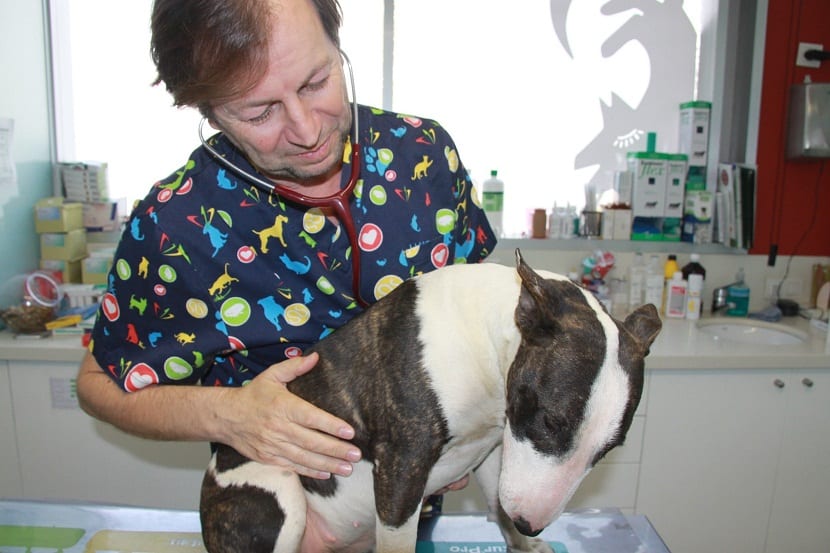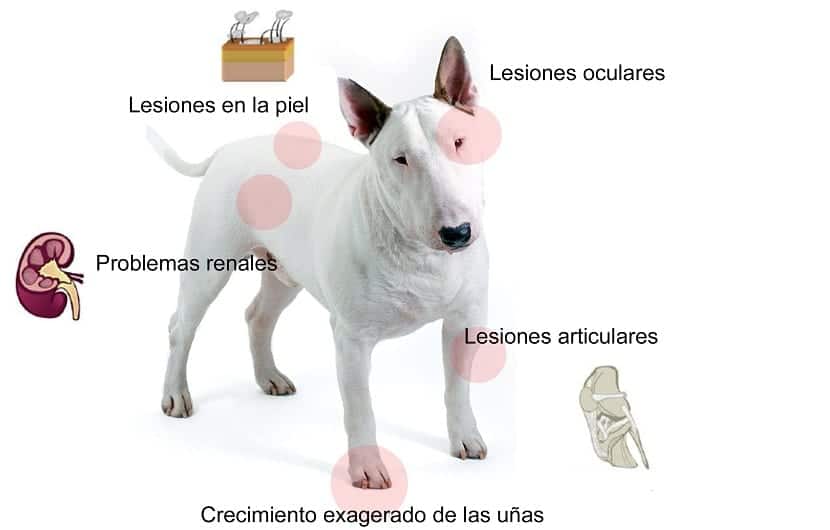
Leishmaniasis is an infectious type disease caused by a species of protozoan parasites of the genus Leishmania, which can damage the skin of our dog and at the same time the mucous membranes, tissues and organs that are responsible for the development of blood cells, such as the marrow, spleen and liver.
This sickness transmitted through mosquito bites infected that feed on the blood and are known by the names of Phlebotomus and Lutzomya.
Symptoms of leishmaniasis

The symptoms of leishmaniasis are highly variable and depending on the type of leishmania infected and the environment, can become benign and in some more severe cases.
Types of leishmaniasis
There are several types of leishmaniasis in dogs, however there are three variants that we can take as the main ones:
- The visceral: It is the most serious of all and can be fatal in most cases.
- The cutaneous: it is the most common, it produces ulcers and leaves some scars that are very visible.
- La mucocutaneous: damages the mucous membranes of the nose, throat and mouth.
Classic cutaneous leishmaniasis
This is the most common way and it is that when the infected sandfly mosquito bites a part of our dog's body, at first a kind of rash forms It begins to grow and when two to four weeks pass a small and painless nodule appears, where after a scab comes off, in this part an ulcer appears with a round shape and with a clean pink background, it is very similar to the crater of a volcano.
This ulcer it can be single and in some cases also multiple. Very often the lymph nodes are affected, this can cause pictures of lymphangitis and lymphadenitis.
In the early months of development, this ulcer will grow depending on the immune response of its host and the type of infected leishmania.
This disease can evolve rapidly, leading to an almost spontaneous cure or in the opposite way. can become even more chronic. When the ulcer heals, in either case it will leave a scar with physical damage that many times can even become psychological.
Mucocutaneous or spurious leishmaniasis
This type of leishmaniasis It can appear months and even years after our pet has been affected.
In this case, the parasites spread through the lymphatic and blood routes through the previous skin lesion that had already healed, breaking into the mucous membranes of the nose and the pharynx area. This type of leishmaniasis appears rarely and it usually occurs when there is an immune or physiological imbalance and also due to some direct trauma to the area of the nose or mouth.
Mucosal lesions begin at the level of the nasal septum, can become chronic and at the same time it spreads very quickly and can perforate and cause irreversible damage to the nasal septum, palate, larynx and nasopharynx, resulting in serious problems for our dog to swallow or speak and in more cases extreme death, something that is due to secondary fungal or bacterial complications.
This type of leishmaniasis never heals spontaneously. Wounds can last for many years if left untreated, and when the infection clears, the affected dog usually needs reconstructive surgery.
Diffuse cutaneous leishmaniasis

This is a very strange form of this disease, it is characterized by the lack of an immune response in the host, cell-mediated versus parasite.
This results in them reproducing in an uncontrolled way, causing a large number of papules to appear, nodules or plaques scattered over the entire surface of the body.
The development of this type of leishmaniasis in dogs It is very slow and does not heal spontaneously, animals that suffer from this disease tend to get worse after having applied the treatment.
Visceral leishmaniosis
It is also known by the name of Kala-Azar. The main organism that serves as a host for this form of leishmaniasis is the domestic dog and when it is not diagnosed or treated in time their mortality rate rises significantly.
After an incubation period of approximately two to four months after the bite of the infected sandfly, symptoms of this disease begin to manifest characterized by presenting a fairly high fever, which can begin in a remitting or intermittent way, which lasts for several weeks, then becomes very insistent and at the same time is accompanied by an advanced deterioration of the dog's state of health sick and because the spleen, liver, bone marrow and lymph nodes are affected.
Dogs that suffer from this disease show a progressive loss of weight until reaching a extreme malnutrition. Likewise, the appearance of depigmented or hyperpigmented spots and fairly large nodules on the surface of the skin becomes very common.
Treatment of leishmaniasis in dogs
The treatment that is used in the first choice of any of the forms of leishmaniasis is with pentavalent antimonials, which exists in two presentations, meglumine antimoniate, which contains 85 mg of the Sbv molecule per ml, and sodium stibogluconate, with 100 mg of it, drugs that work by interfering with the bioenergetics of the parasite.
On the other hand, between second-choice treatments in case the parasite opposes resistance to pentavalent antimonials we can find the following:
Amphotericin, which is a very polyene antifungal active that is used against leishmaniasis and is administered intravenously. Its use is very limited since it causes very serious adverse complications.

Pentamidine isothionate, this being an aromatic drug derived from diamidine. It is more toxic than amphotericin B and pentavalent antimonials.
Paramomycin sulfate, an aminoglycoside antibiotic that administered intramuscularly which prevents protein synthesis and in turn alters the absorption of the parasite's cell membrane.
Miltefosine, which thanks to its mechanism of action allows the inhibition of the metabolism of the lipid membrane of the parasite. It is administered orally and also causes nausea, diarrhea, vomiting and abdominal pain.
Distribution of leishmaniasis in Spain
At least four species of sandflies are found in the Iberian Peninsula and in the Balearic Islands, this insect it is characterized by being very hairy, only a few millimeters in size and yellow in color.